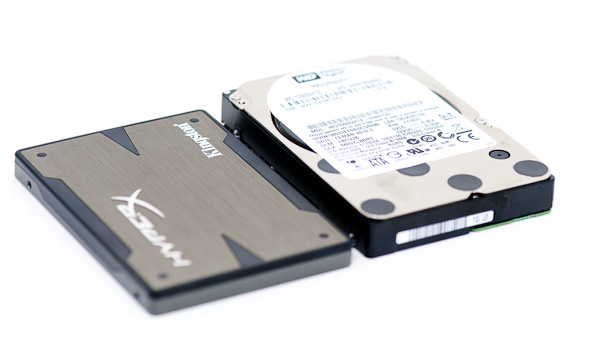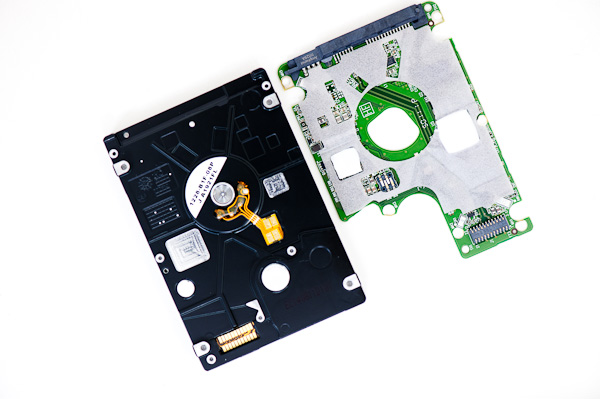Western Digital VelociRaptor 1TB (WD1000DHTZ) Review
by Anand Lal Shimpi on April 16, 2012 8:00 AM EST- Posted in
- Storage
- HDDs
- Western Digital
- VelociRaptor
Final Words
The new VelociRaptor does reclaim its title as world's fastest client hard drive, and I do appreciate the fact that WD hasn't raised prices on the drive in the past two years either. Compared to any 3.5" drive on the market today, the new VR is significantly faster without a doubt. Random IO performance is at least double most 3.5" drives, and sequential performance is almost 50% better than the fastest competitors. Most impressive is the fact that power consumption is actually competitive with modern 3.5" green drives as well, another benefit of the VR's 2.5" package.
The biggest problem for the new VR today is the same issue we had two years ago: SSDs are much faster, and are quickly becoming more affordable. As a primary drive I wouldn't recommend the VelociRaptor simply because you can get a better overall experience with an SSD. We have a number of very reliable, reasonably affordable (128GB), high-performing SSD options to choose from. Intel's lineup, Samsung's SSD 830 and Crucial's m4 all come to mind.
As secondary storage, the new VelociRaptor appeals to those users who need more capacity than an SSD can affordably offer, for active use. Launching applications, games, and working on (not just streaming for playback) large data files are all going to be quicker on the VR than on a standard 3.5" drive. If you're building the ultimate workstation, you could use an SSD + VR for internal storage coupled with some larger, slower drives in RAID as a backup or for your more passive data (movies, music, edited photos). For most users however, I'd honestly recommend an SSD plus a couple of large, 5400/7200RPM drives in RAID-1 for everything you can't store on your SSD. While the Raptor line was quickly embraced by the enthusiast, I believe it has transitioned exclusively to a workstation role.
I have to admit I was disappointed to see that Western Digital went conservative on the new VelociRaptor design and didn't include any on-board NAND to really mix things up. What I was hoping for was a combination of the VelociRaptor and Seagate's Momentus XT. Perhaps that doesn't make sense given the available SSD caching solutions available today, but I don't see the harm in pairing even a small amount of NAND with the drive. I don't see hard drives going away anytime soon, so we might as well try to make accessing them as quick as possible.
Then there's the extreme option. I would love to see a manufacturer treat a hard drive as an SSD with a mechanical counterpart, rather than a hard drive with some NAND on it. I'm curious to see what a VelociRaptor (or any other 2.5" HDD) with 64GB of NAND used as a read/write cache would behave like. If users are able to fit all of their program, apps and data into a 128GB SSD, I have to believe that a well managed cache can deliver compelling performance with half that space.
Unfortunately most hard drive companies seem slow to adopt NAND into their designs, so I suspect much of this will have to be a dream for now. The new VelociRaptor is a great evolution of the design and it's truly a very fast hard drive. Just as before, if I needed to buy a high-performance mechanical hard drive, it's the one I'd pick.












92 Comments
View All Comments
justniz - Monday, April 16, 2012 - link
As this is apparently just a 2.5" SATA drive attached to a big heatsink, would there be any issues if you unmounted it from the heatsink and put it in a laptop?Does the drive really generate so much heat it needs a heatsink to run?
I'm guessing that the only real problem would be because its a 10k spin speed it consumes slightly more power than a conventional drive, so your maximum time on just battery power would suffer a little.
kyuu - Monday, April 16, 2012 - link
Sticking one of these in a laptop would probably be a bad idea due to power usage, noise, and heat.kyuu - Monday, April 16, 2012 - link
Oh, and vibration.jabber - Monday, April 16, 2012 - link
Yeah and arent they thicker too?Nihility - Monday, April 16, 2012 - link
It's twice as thick as a 7mm drive.kmmatney - Monday, April 16, 2012 - link
For a laptop, the Seagate Momentus XT is just a way better option...TiGr1982 - Tuesday, April 17, 2012 - link
It is . Recently I upgraded my laptop (Acer 7552G, AMD Danube platform, SB850 sourhbridge) with Seagate Momentus XT 750 GB, and now it runs MUCH faster than before, because HDD is no longer the bottleneck.eanazag - Monday, April 16, 2012 - link
I won't buy the mobile Seagate XT with NAND simply because it does not support RAID. Has anyone RAIDed an XT and have some reliability experience on this in RAID 5, 1, and 0? I would opt for a few of these for cheap storage servers and when SSD caches fail to hold the requested data. I do wish the power usage was a little lower, but this is a really inexpensive enterprise drive.I bought 74GB Raptors when the max size was 150GB. I had 2; one is still chugging and one keeled over after 6 years. The dead one died in a VMware server where I was using it to hold install ISOs. I have been happy with them.
With linear scaling I like 2 or 3 of these in RAID 0. 400MB-600MB of seq. read and write.
kyuu - Monday, April 16, 2012 - link
What? You can RAID the Momentus XTs just fine. Where did you hear that you can't RAID them?Ramon Zarat - Monday, April 16, 2012 - link
Still have the 36GB version in my file server boot drive (used to have 2 in RAID0 on my main computer). Has been running practically non stop for nearly 10 years now! Not even a single bad sector. Amazing quality.